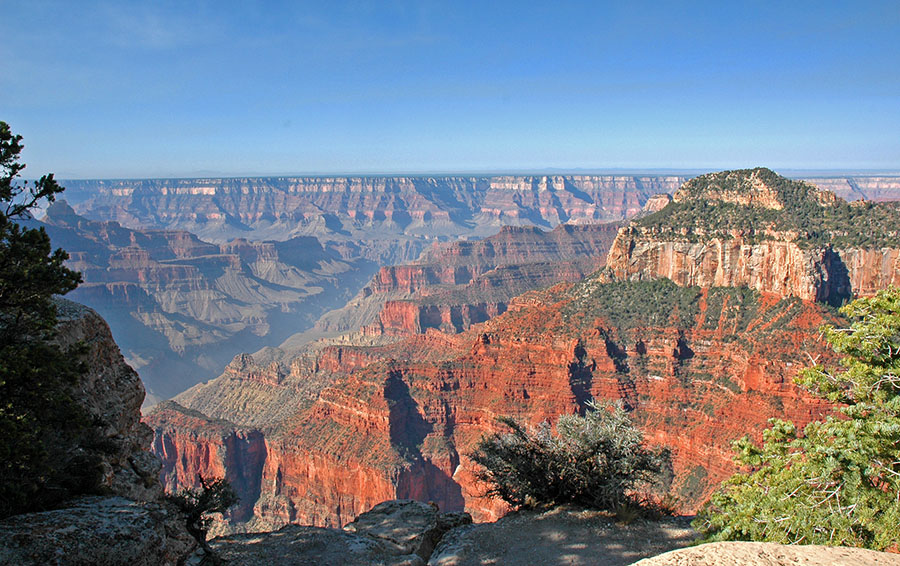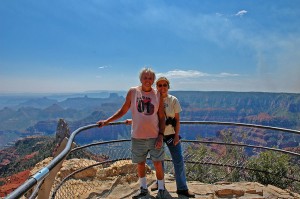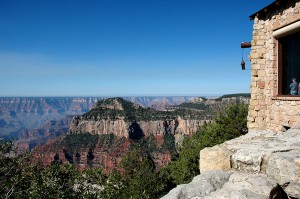 Grand Canyon National Park is one of the most popular National Parks in western North America, and it’s often referred to as “The Earth’s greatest geological showcase.” The canyon itself has to be seen to be believed, its erosional forms are spectacular. The colorful rock layers, buttes, and side canyons make for a scenic photographer’s paradise. The average distance rim-to-rim is 10 miles as the condor flies with the largest span being 18 miles across. The park itself encompasses over one million acres that accommodates over five million visitors each year. Ninety percent of those people go to the South Rim, the more arid desert-like side of the canyon. The North Rim is far less busy and abuts the Kaibab Plateau. This side is basically an island of lush plants and forest surrounded by desert, and it’s far less arid. For us it was a no brainer, we went to the North Rim.
Grand Canyon National Park is one of the most popular National Parks in western North America, and it’s often referred to as “The Earth’s greatest geological showcase.” The canyon itself has to be seen to be believed, its erosional forms are spectacular. The colorful rock layers, buttes, and side canyons make for a scenic photographer’s paradise. The average distance rim-to-rim is 10 miles as the condor flies with the largest span being 18 miles across. The park itself encompasses over one million acres that accommodates over five million visitors each year. Ninety percent of those people go to the South Rim, the more arid desert-like side of the canyon. The North Rim is far less busy and abuts the Kaibab Plateau. This side is basically an island of lush plants and forest surrounded by desert, and it’s far less arid. For us it was a no brainer, we went to the North Rim.
The altitude on the rim varies around 8,000 feet in elevation making for pleasant cool late summer nights, but the days can still be hot, especially on exposed trails. We tent camped at the North Rim Campground after reserving a site overlooking a scenic side canyon. The campground was well kept and comfortable, and the overlook made for great happy hours. Fees are similar to other National Parks and you can check on these at www.recreation.gov/(park),or call (887) 444-6777. You are limited to seven days camping, and there are no hook-ups available. There is a small store next to the campground for snacks and basics, but if you plan on doing much cooking load up the cooler before you enter the park. Shower and laundry facilities are available close to the store. There’s a gas station near the Park’s entrance, and you should fill up on the way in. As in other National Parks, pets are not allowed on most trails, but they’re okay on a leash in the campground. Permits and fees are required for overnight camping if you descend from either rim for an overnight trip into the canyon. Bicycle trails are available for easy access to most areas of the park.
The weather can vary during the day, and afternoon lightning storms are fairly common. If you hike down into the canyon, extreme elevation changes influence temperatures and flash flooding can occur, so be careful and be prepared. This is a very dry climate otherwise, so carry plenty of fluids on the trail. On a good day visibility often reaches 100 miles.  That really makes for spectacular geological views, and that’s why people come to visit. Experts are still working on the geology of the canyon, but a lot of it is well documented. There are a large number of books on this subject available, and it will enhance your experience if you read up on the canyon before your visit. You might want to check out the National Geographic’s Grand Canyon Guide Map edition for starters.
That really makes for spectacular geological views, and that’s why people come to visit. Experts are still working on the geology of the canyon, but a lot of it is well documented. There are a large number of books on this subject available, and it will enhance your experience if you read up on the canyon before your visit. You might want to check out the National Geographic’s Grand Canyon Guide Map edition for starters.
There’s a Visitors Center and book store near the North Rim Grand Canyon Lodge where on-site information is available. Rangers are happy to answer your questions and help with planning an itinerary based on your interests. They also have guided nature walks and campfire programs. We especially enjoyed several talks scheduled daily at the lodge. These cover a variety of topics including the canyon’s geology, the California condor recovery program at nearby Vermillion Cliffs, and others.
 If you don’t want to camp, the lodge is a great place to stay. Information is available on their website at www.GrandCanyonForever.com, or call (877) 386-4383. The dinners there are excellent too, but get there early if you want a table with a view. There are also other limited food options near the lodge. Camping, lodging, and food services are available outside the park, but transit time is involved.
If you don’t want to camp, the lodge is a great place to stay. Information is available on their website at www.GrandCanyonForever.com, or call (877) 386-4383. The dinners there are excellent too, but get there early if you want a table with a view. There are also other limited food options near the lodge. Camping, lodging, and food services are available outside the park, but transit time is involved.
We enjoyed several popular day hikes while we were in the park. Most of these are short and scenic and can be researched on the web in advance. Longer hikes are popular too, but require rapid elevation changes. Popular easy day hikes include the half mile round trip Bright Angel Point Trail next to the Lodge, Bridal Trail, a 1/2 mile, one way hike, and the Transport Trail from the campground to the Lodge, which is about 3 miles round trip and you can have breakfast in between if you start your day that way. The 45 mile drive to the short scenic Cape Royal Trail was interesting, too.
Critters you’ll probably see include mule deer, horned lizards, the funny looking white tailed, long eared, Kaibab squirrel, and bison in the fields off the road near the park entrance. Rarer wildlife sightings include turkeys, big horn sheep and mountain lions. The California condor soars over the canyon on up-drafting winds most afternoons, and we were fortunate to see several of these, or maybe the same ones several times. The flora varies wildly with elevation changes, and a wide variety of local plant life can be found along with the usual widespread specimens.
So far we haven’t gone to the South Rim, but we will someday, and the contrast should be interesting. There is a 215-mile road between the two rims, and that transit would take you five hours or so. But, if you wanted to visit both sides of the canyon on the same trip, you could. All in all, this was a great trip for us. We’ll go back, and we highly recommend you try it sometime.
